Cold-Temperature Damage to the 2023 Missouri Wine Grape Crop
Dean S. Volenberg, Viticulture Extension Leader
Wine grapes are produced on one-year-old wood. The 2023 Missouri wine grape crop started off as fruit buds in early June 2022. The fruit buds matured as the 2022 grape crop was nearing harvest. In Missouri, grape harvest begins around mid-August and finishes around Nov. 1. Late maturing cultivars such as Norton and Chambourcin experienced an early killing frost on Oct. 18, 2022 (Figure 1). Ideally, grapevines should have four to six weeks of a full canopy after fruit harvest. During that period, the spurs, cordons, trunks and roots become sinks for carbohydrates. Prior to harvest the grape clusters are the primary sinks for carbohydrates. An early killing frost near the time of harvest limits carbohydrates going to storage structures of the grapevine. Bud cold-hardiness can also be reduced. At leaf fall, grape buds have a moderate degree of hardiness to cold temperatures in the range of 5 to 20 degrees F.
Besides temperature, a number of abiotic stresses can also reduce bud cold hardiness. Many vineyards experienced drought conditions during the 2022 growing season. The extent of the drought was exemplified in Executive Order 22-04 whereas numerous areas of Missouri experienced the negative impact of the drought. When Executive Order 22-04 was issued on July 21, 2022, fifty-three counties were in severe or extreme drought. Drought conditions can impact a bud's ability to attain cold hardiness.
Grapevines experienced severe cold temperatures on Dec. 22 and 23, 2022 (Figure 2). Air temperatures were below zero, which resulted in damage to primary buds of a large number of wine grape cultivars (Table 1). These early winter cold temperatures occurred prior to grape buds attaining maximum cold hardiness. Grape buds have maximum cold hardiness during January and February. Cold hardiness of buds is cultivar dependent. Research from Cornell University in Geneva, NY suggests that Chardonel and Chambourcin buds are the most sensitive to cold temperatures based on lethal temperature that kills 50% of the buds or LT50 values compared to other intraspecific cultivars buds (Table 2). Indeed, Chardonel and Chambourcin had a high percentage of primary bud death when evaluated in January 2023 (Table 1).
Grapevine growth as defined as bud break began around April 15, 2023, in central Missouri. Vineyards located in the more southern areas of the state experienced bud break prior to April 15. In comparison, vineyards located in more northern areas of the state experienced bud break after April 15. Bud break is driven by the accumulation of heat units or growing degree days. A string of warm days and warm nights occurred from April 11 to 15 that resulted in bud break in central Missouri. Grapevine growth was evident throughout Missouri from April 15 to April 23.
Grapevine shoot growth succumbed to below freezing temperatures on April 23 and 24, 2023 (Figure 3 and Figure 4). These frost/freeze events negatively impacted most vineyards in Missouri (Figure 5 and Table 3). Developing shoot growth was killed by air temperatures below 32 degrees F (Figure 6). Some vineyards escaped damage based on site selection, whereas some grape cultivars in northern areas of Missouri had remained dormant and green tissue was not exposed to cold temperatures. In some southern counties, below-freezing temperatures only occurred on April 23.
In summary, the 2023 wine grape vintage was negatively impacted by a number of abiotic stress factors. The 2022 drought likely started the demise of the 2023 wine grape crop. Grapes are produced on 1-year old wood and the fruitful buds are established in the previous growing season. Drought conditions are known to impact grape buds' ability to attain cold hardiness. An early killing frost on Oct. 18, 2022, completely eliminated the potential of grapevines to continue to store carbohydrates. Ideally, grapevines need a full leaf canopy for four to six weeks after harvest to store carbohydrates. On Oct. 18, 2022, not all vineyards had been harvested. Grape buds were then exposed to extreme cold conditions on Dec. 22 and 23, 2022. These temperatures killed a high percentage of primary buds across a wide range of cultivars. As the 2023 grape vintage began to grow near mid-April, late-April frost events killed developing shoots throughout Missouri. I estimate production will likely be reduced by 60 to 70% of average. As an example, production will range from 1.05 to 1.4 tons/acre (based on an average production of 3.5 tons/acre). These yields will not cover production and harvest costs in 2023 (based on price/ton in 2022).
top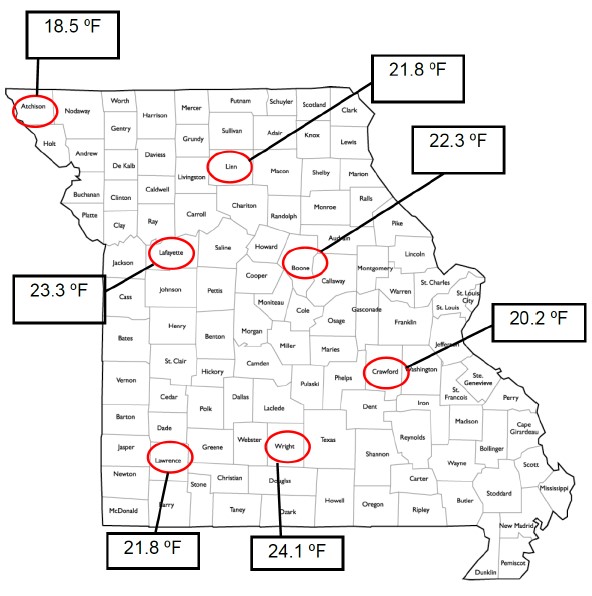
top
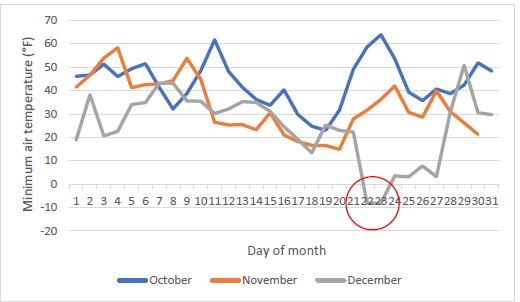
top
Table 1. Primary and secondary bud survival of selected grape cultivars, cane wood collected on Jan. 19, 2023 in Gasconade County, Missouri.
| Cultivar1 | Dead primary buds (%) |
Dead secondary buds (%) |
|---|---|---|
| Chambourcin | 63 | NA2 |
| Chardonel | 60 | NA |
| Concord | 40 | 13 |
| Norton vineyard 1 | 12 | NA |
| Norton vineyard 2 | 21 | NA |
| Norton vineyard 3 | 45 | NA |
| Vidal blanc | 76 | NA |
| Vignoles | 25 | 5 |
| Average | 43 | 9 |
1 A total of 10 canes with five to six buds per cane were evaluated per cultivar.
2 NA represents that secondary buds were not evaluated.
top
Table 2. The temperature at which 50% of the grape buds will freeze. Buds were sampled during the period of January through mid-February in Geneva, New York. The average LT50 is presented based on the number of years evaluated.
| Cultivar | 1LT50 (degrees F) |
Years (No.) |
|---|---|---|
| Chambourcin | -11.74 | 16 |
| Chardonel | -10.9 | 10 |
| Valvin muscat | -14.2 | 14 |
| Vincent | -12.2 | 2 |
| Vidal blanc | -12.5 | 6 |
| Vignoles | -11.8 | 6 |
| Catawba | -13.9 | 6 |
| Concord | -18.0 | 15 |
1 Data from Cornell University: https://grapesandwine.cals.cornell.edu/extension/bud-hardiness-data/about/midwinter-bud-hardiness-selections-cornell-grape-breeding-program/
top
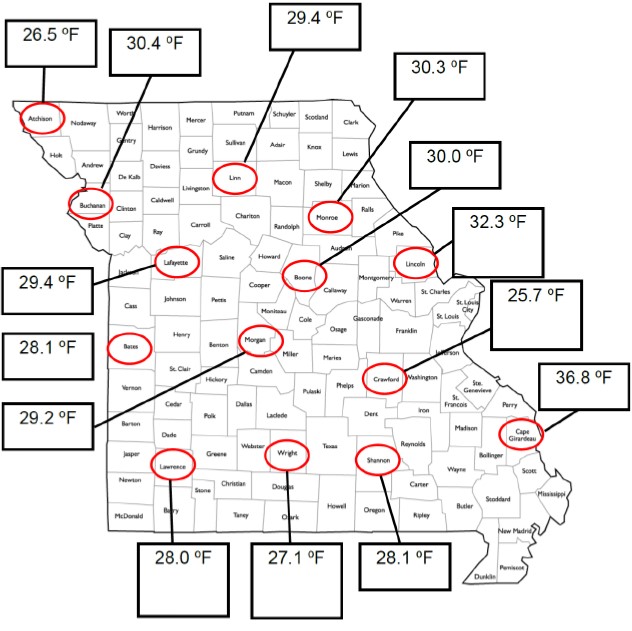
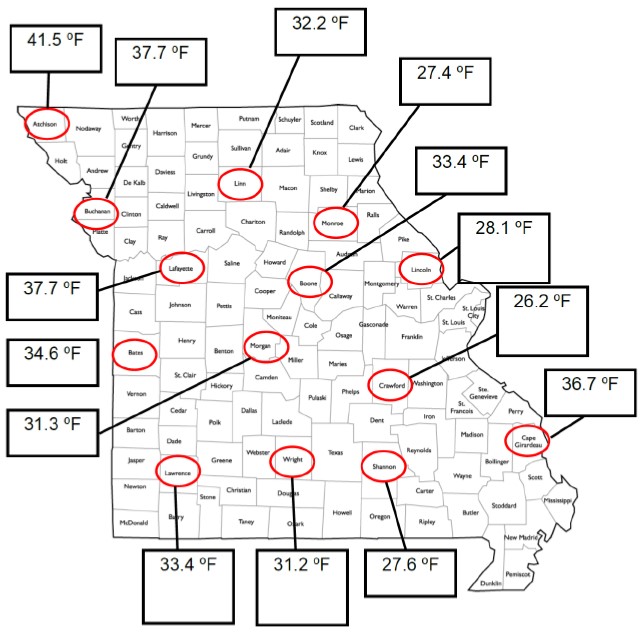

Table 3. Reports of frost/freeze damage observed and recorded by the author or reported by grape growers to the author. Reports are reporting on specific frost/freeze damage that occurred from April 23 or 24, 2023.
| County | Report |
|---|---|
| Macon | Marechel Foch and St. Vincent emerged and frost damaged. Chambourcin and Vignoles not damaged by April 2023 frost/freeze. |
| Audrain | Vignoles and Chambourcin damaged by April 2023 frost/freeze. All Vitis vinifera damaged by April 2023 frost/freeze. |
| Boone | All cultivars with emerged shoots damaged by April 2023 frost/freeze. Vitis vinifera cultivars heavily damaged likely that vascular damage is extensive. |
| Gasconade | Vineyards located at high elevations had no frost/freeze damage from April 2023 events. V. labrusca including Concord and Catawba had 6-inch shoots when frost/freeze events occurred. No damage on these cultivars. |
| Franklin | All emerged tissue on Chambourcin and Vignoles killed by frost/freeze April 2023 events. |
| St. Charles | Most all vineyards in the Augusta area experienced frost freeze damage from the April 2023 events. Except St. Vincent was damaged. A 2-acre Cabernet Sauvignon block was severely damaged by December 2022 cold events. |
| Ste. Genevieve | Vignoles and Chambourcin damaged by April 2023 frost/freeze. V. vinifera severely damaged by late fall and or early winter cold events of 2022. |
| Phelps | All cultivars with emerged shoots damaged by April 2023 frost/freeze. Approximately 85% frost/freeze damage. Cayuga likely damaged by late fall and or early winter cold events of 2022. V. labrusca cultivars undamaged by April frost/freeze events. |
| Wright | All cultivars damaged by frost/freeze events of April 2023. As of early May, estimated that fruit production will be minimal or approximately 1/3 of an average yield. |
| Lawrence | April frost/freeze events did not impact vineyards in Lawrence County. Primary bud damage was 40 to 60% depending on cultivar from late fall or early winter cold events in 2022. |
| Clay and Ray | April frost/freeze event was April 23 only. This was a limited duration cold event. Some damage occurred to emerged shoots. Damage was also dependent on vineyard site. |
top
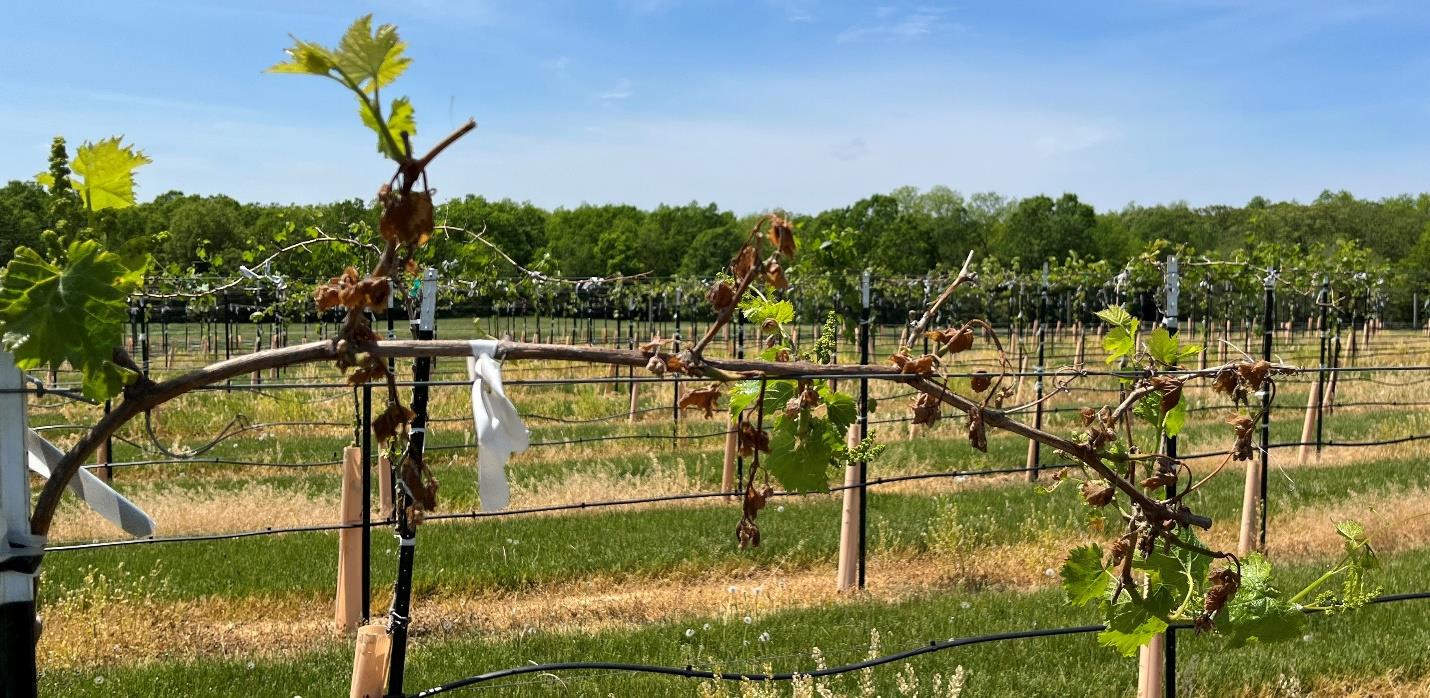
Photo credit: Dean S. Volenberg, 5.25.2023.
top